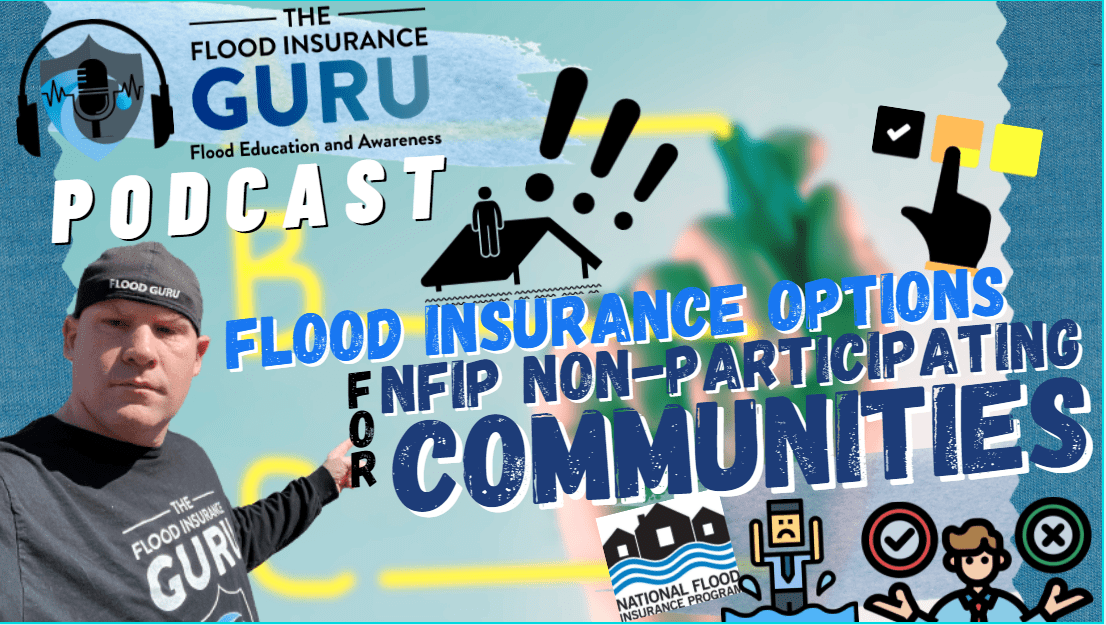The Flood Insurance Guru Podcast Episode 26: My Community Doesn't Participate in NFIP. What are My Flood Insurance Options?
August 30th, 2019
3 min read
By Chris Greene

At the time of writing, the only way you can get through the National Flood Insurance Program (NFIP) under Federal Emergency Management Agency (FEMA) is if you're in a community that's participating with them. If you're also doing a Federal Housing Administration (FHA) loan, you're basically required to get flood insurance through the NFIP only, but what if you're doing an FHA loan however you're not in a participating community?
So, today, let's answer the question, what if being a participating community is out of the picture and where can you get your flood insurance if the National Flood Insurance Program (NFIP) flood policy isn't available for you?

Participating Communities
When it comes to flood insurance in the U.S., there are certain guidelines and floodplain regulations that you and your community have to follow in order to get your flood insurance policy from the federal government's program. The National Flood Insurance Program (NFIP) arranged the Community Rating System in 1994 to help communities get a score on their overall flood mitigation efforts and reducing flood risks. Once you become a participating community, you have to follow their standards on flood mitigation to raise your scores and be able to stay within the program.

Participating communities are areas that had an agreement with the National Flood Insurance Program (NFIP) to do everything to meet floodplain management regulations, flood mitigation standards, and reducing flood risks for their community and residents. It's important to note that these communities are rewarded with a lot of perks when they participate. Other than being able to get access to the standard flood insurance policy, participating communities also get access to disaster aid and disaster grants. This is really helpful when you're in an area that gets hit hard by natural disasters like earthquakes, tornadoes, and flooding.
Community Rating System
Now, we've mentioned that basically, you're city or area is going to be scored by the National Flood Insurance Program (NFIP) and FEMA when you're participating with them. This score is called the Community Rating System (CRS). The CRS basically rates the community's overall results on flood mitigation and reducing the risk of flooding in their community based on FEMA's standards. This includes but isn't limited to proper elevation on properties, proper flood openings, mitigating drainage systems, and floodways. Upon assessment, FEMA will provide an overall rating that can give discounts of up to 45% on flood insurance premiums even for homeowners with properties in the high-risk flood zones.
You can learn more on participating and non-participating communities by checking out our previous podcast episode:
Flood Insurance Options for
Non-Participating Communities
Now, let's say that your community decided not to participate with the NFIP or it was removed from the participation program; this means that you won't really have access to federal flood insurance, disaster assistance, and disaster grants.
There's always private flood insurance or also known as the private market flood. Now, it's important to note that if you're doing an FHA loan, this is basically the only exception for getting a flood policy from private insurance companies. Flood insurance rates are significantly lower compared to the NFIP even if you're in high-risk areas with flood claims being processed a lot shorter as well.

A private policy can get you the same coverage as the NFIP can, if not more. First, when it comes to structure or building coverage from flood damage, private flood insurance can provide up to $10,000,000 since they generally don't have a maxed amount for flood insurance coverage compared to the National Flood Insurance Program where you basically stop at $250,000 for residential properties. Flood coverage for personal property isn't bound by coverage limits as well, so you can get up to $1,000,000 for the contents of your listed property if it were to be impacted by flood damage.

Private flood policy from private companies also has additional coverage that you won't get from the NFIP and FEMA. This includes additional living expenses, replacement costs, and loss of use. This is drastically helpful when facing a lot of flood loss. Apart from this, you can also include multiple buildings in a single policy outside of the main property itself — something that the NFIP and FEMA will generally require you to get a separate policy for.
It's important to keep your property protected against flood or any disaster at all times. These things are basically our lives and we spent a good portion of ours investing in them. If you have any questions on your flood insurance options, remember, we have an educational background on flood mitigation and we want to share this knowledge with you. Feel free to click the links below to get started on being a part of our mission to share flood education and awareness:




